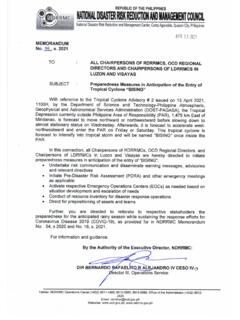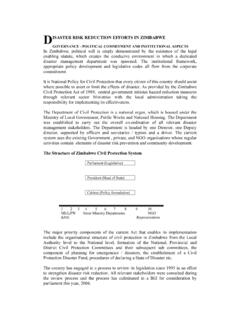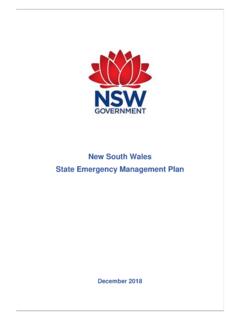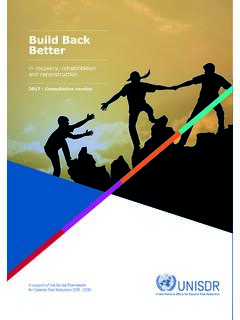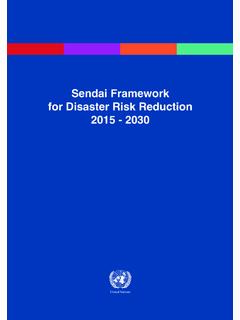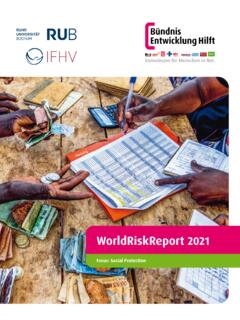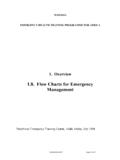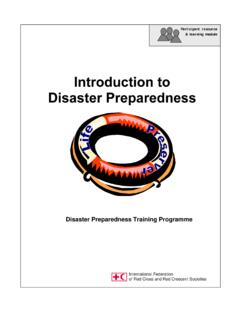Transcription of National Disaster Response Plan (NDRP)
1 National Disaster Response plan (NDRP) Consequence management for Terrorism-related Incidents 1 CONTENTS CHAPTER I BACKGROUND .. 3 8 ACRONYMS .. 13 CHAPTER II National Crisis management 101 NCM Framework .. 15 Executive Committee and Sub-Committees .. 16 Anti-Terrorism Council .. 16 CMC and Response Cluster Inter-Operability .. 20 CHAPTER III THE NDRP FOR CONSEQUENCE management What is NDRP?.. 22 Where is NDRP applicable? .. 23 When is NDRP activated? .. 24 Who are the Key Players? .. 30 How NDRP works?.. 32 CHAPTER IV NDRP BRIDGING AND COORDINATING MECHANISMS Philippine Response Cluster System (RCS).
2 36 Incident Command System (ICS) .. 37 Inter-operability of RC and IMT .. 39 Co-Location Strategy .. 40 Coordination with the Militaries AFP .. 41 Coordination with International Humanitarian 42 2 CHAPTER V ACTIVITIES, COMMON TOOLS AND SERVICES Rapid Damage Assessment and Needs Analysis (RDANA) .. 44 Common and Fundamental Operational Data Sets (CAFOD) and Information management -Technical Working Group (IM-TWG) .. 45 Response Cluster s Information management System .. 47 ANNEX Incident management Team Duties and Selection .. 48 Lead Cluster Operational Protocols.
3 49 131 3 CHAPTER I In Disaster Response management operations, we abide by the formula: P + P + P = O as our mathematical binding principle, anchored on the whole-of-nation approach which purports that Public + Private + People is equal to Zero Casualty. LTC EDWIN C SADANG, GSC (SC) PA SMA for Operations, OCD BACKGROUND It is a known fact that the Philippines is prone to natural hazards such as typhoons, earthquakes, volcanic eruptions, landslides and tsunamis. Given our Disaster risk profile, Republic Act (RA) 10121, otherwise known as the Philippine Disaster Risk reduction and management Act of 2010 , was enacted on 27 May 2010.
4 This law paved the way for the institutionalization of the proactive Disaster Risk reduction and management or DRRM approach, which is the systematic process of using administrative directives, organizations, and operational skills and capacities to implement strategies, policies and improved coping capacities in order to lessen the adverse impacts of hazards and the possibility of Disaster . However, apart from natural hazards, human-induced hazards such as crimes and terrorism further threaten the lives of the communities. Moreover, the circumstances regarding emergencies became even more complex with the phenomenon of the new normal , characterized by the increasing frequency, magnitude and scope of disasters, as well as the blurring of division between the disasters caused by natural and human-induced hazards.
5 Presently, terrorism, also a human-induced hazard, continues to become a global concern. As described by Republic Act 9372, terrorism is an act that causes widespread and extraordinary fear and panic among the populace. With the growing threat of terrorism in the Philippines, the National Disaster Risk reduction and management Council (NDRRMC) has to be on guard and prepare for the possible consequences that may arise. Hence, the National Disaster Response plan (NDRP) for managing consequences related to terrorism has been prepared. The Disaster Risk reduction and management Act of 2010 strengthens the Philippines implementation of actions and measures for direction and mitigation in catastrophes and is a very important step towards achievement of an enhanced Response program for Disaster risk reduction .
6 Based on the provisions the participation of civil society organizations (CSOs), the private sector and volunteers in This chapter provides a general background of the NDRP, including the terminologies and acronyms used in this document. It covers the Rationale and Objectives of the NDRP, and the Bases of Actions. 4 the government s Disaster risk reduction programs towards complementation of resources and effective delivery of services to the citizenry , the government can direct other groups in the country to join resources towards the domain of Disaster risk and reduction management programs. This opens up institutional capacity to bolster good relationships among Response operations key players that may result to institutional interoperability.
7 As such, the Philippine Government, through the National Disaster Risk reduction management Council (NDRRMC) has formulated several memorandums, guidelines, and protocols that call for a more efficient and effective mitigation of, preparedness for, Response to, and recovery from Hydro-Meteorologocial induced disasters. Objectives of the NDRP The NDRP is the National Government s strategic action in providing Response assistance for managing the consequences of terrorism related incidents. It aims to ensure the timely, effective and coordinated Response by the National Government including its instrumentalities by providing support assistance to the areas that will be affected by terrorist acts.
8 The NDRP acknowledges and supports the principles of the Local Government Code (RA 7160) wherein all LGUs are mandated to prepare and render Response for all eventualities of Disaster within their boundaries. The NDRP embraces all conceivable contingencies, making use of all available resources from the government, non-government organizations, private sectors, volunteer groups and other Response operations key actors. It promotes self-reliance and mutual-help, with the full utilization of available resources before seeking assistance from neighboring or higher entities. Since emergency Response is a joint responsibility of the National and local governments, its effectiveness will depend largely on the level of preparedness done by the different levels of the local government units (Province, City and Municipality) as well as that of the field offices and attached agencies of the different National government agencies.
9 The manner of Response that will be provided by the National Government through this NDRP heavily relies on the capacities and capabilities of the different levels of the local government. It is important that the LGUs are well-versed on Disaster Preparedness plan as a foundation for effective Response operations. NDRP in Perspective The NDRP is the Government of the Philippines multi-hazard Response plan . Emergency management as defined in the NDRRM Act of 2010 (RA10121), is the organization and management of resources to address all aspects or phases of the emergency, mitigation of, preparedness for, Response to and recovery from a Disaster or emergency.
10 The Department of Social Welfare and Development (DSWD) with Office of Civil Defense (OCD), in consultation with NDRRMC member agencies developed/formulated the NDRP. It outlines the processes and mechanisms to facilitate a coordinated Response by the National and/or at the local level departments/agencies. Local government institutions are responsible for the development and improvement of local Response plans relative to their areas of responsibility and underlying risks . The 5 relationship between the NDRP and other plans in National and local levels is shown in Figure 1. Figure 1 NDRP in Perspective The NDRP prescribes the relevant activities on how the Disaster Response shall be conducted as augmentation or assumption of Response functions to the Disaster affected LGUs as a result of terrorist attacks.



